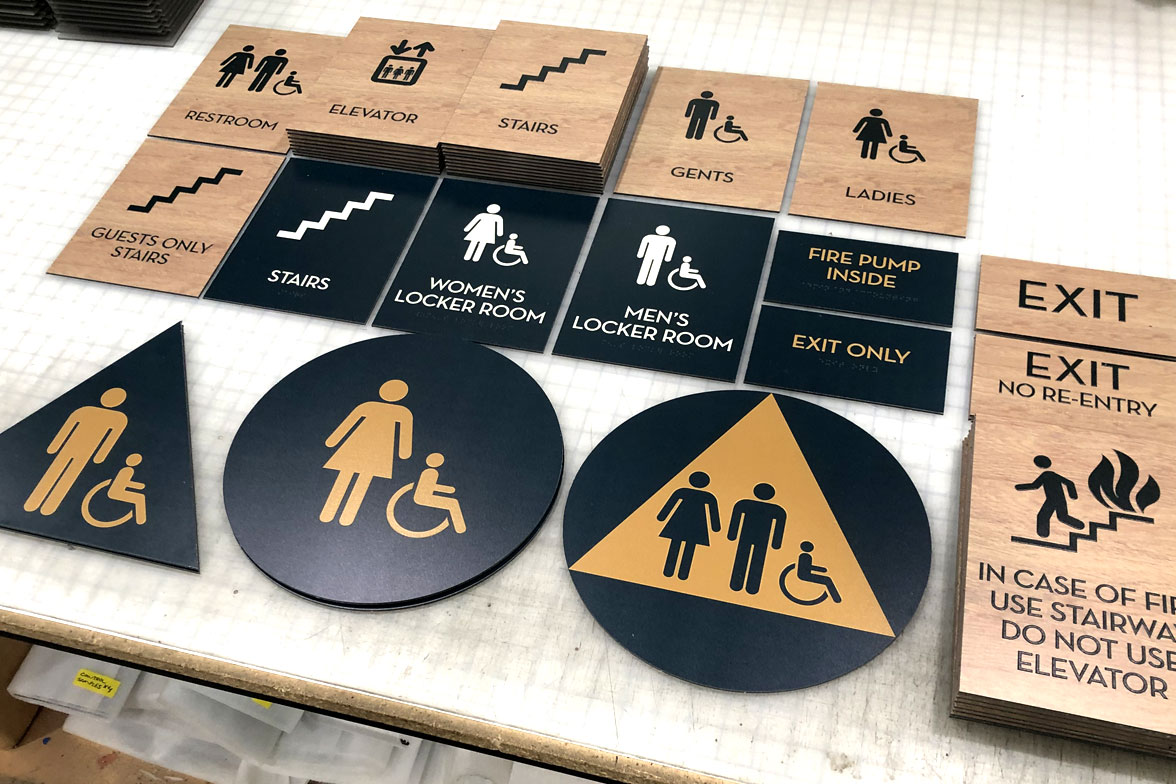Checking Out the Secret Functions of ADA Indications for Improved Availability
In the realm of accessibility, ADA indicators serve as quiet yet powerful allies, making sure that areas are accessible and inclusive for individuals with specials needs. By integrating Braille and responsive components, these indications damage barriers for the visually damaged, while high-contrast shade schemes and readable typefaces cater to diverse aesthetic needs.
Value of ADA Conformity
Guaranteeing conformity with the Americans with Disabilities Act (ADA) is essential for cultivating inclusivity and equivalent access in public areas and work environments. The ADA, enacted in 1990, mandates that all public facilities, companies, and transportation services fit people with disabilities, ensuring they take pleasure in the very same rights and opportunities as others. Compliance with ADA requirements not just meets lawful commitments but also improves a company's track record by showing its dedication to variety and inclusivity.
Among the key aspects of ADA compliance is the implementation of easily accessible signs. ADA indications are made to make certain that people with disabilities can easily navigate through structures and spaces. These indications need to stick to details standards regarding size, font, color contrast, and placement to guarantee visibility and readability for all. Correctly executed ADA signage assists get rid of obstacles that individuals with specials needs usually encounter, thereby promoting their self-reliance and self-confidence (ADA Signs).
Additionally, sticking to ADA regulations can alleviate the risk of prospective fines and lawful repercussions. Organizations that fall short to follow ADA guidelines might deal with charges or lawsuits, which can be both monetarily difficult and damaging to their public picture. Thus, ADA conformity is integral to promoting an equitable atmosphere for everyone.
Braille and Tactile Components
The unification of Braille and responsive elements into ADA signage symbolizes the concepts of access and inclusivity. It is generally placed underneath the corresponding message on signage to guarantee that individuals can access the info without aesthetic aid.
Tactile aspects prolong beyond Braille and include raised symbols and personalities. These parts are made to be noticeable by touch, enabling individuals to identify room numbers, restrooms, exits, and various other critical locations. The ADA establishes certain guidelines concerning the size, spacing, and positioning of these responsive aspects to optimize readability and ensure uniformity throughout different environments.

High-Contrast Color Design
High-contrast shade plans play a critical duty in improving the visibility and readability of ADA signs for individuals with visual problems. These plans are essential as they take full advantage of the difference in light reflectance between text and history, guaranteeing that indicators are quickly noticeable, even from a range. The Americans with Disabilities Act (ADA) mandates making use of details color contrasts to suit those with restricted vision, making it an essential facet of compliance.
The effectiveness of high-contrast colors depends on their capacity to stand apart in numerous illumination problems, including poorly lit environments and locations with glare. Commonly, dark text on a click here for info light history or light text on a dark background is used to achieve optimum contrast. For circumstances, black message on a white or yellow history offers a raw visual difference that helps in fast recognition and understanding.

Legible Fonts and Text Dimension
When taking into consideration the style of ADA signs, the selection of readable typefaces and proper message size can not be overstated. These elements are vital for making certain that signs are accessible to individuals with visual impairments. The Americans with Disabilities Act (ADA) mandates that fonts should be sans-serif and not italic, oblique, script, extremely ornamental, or of unusual type. These demands assist guarantee that the text is quickly understandable from a distance and that the characters are distinguishable to varied target markets.
According to ADA standards, the minimum text elevation need to be 5/8 official statement inch, and it must enhance proportionally with viewing range. Consistency in message dimension contributes to a natural visual experience, assisting individuals in browsing atmospheres efficiently.
Moreover, spacing between lines and letters is essential to clarity. Ample spacing prevents characters from appearing crowded, enhancing readability. By adhering to these requirements, developers can considerably improve ease of access, making certain that signage serves its intended objective for all people, despite their visual capacities.
Effective Placement Approaches
Strategic placement of ADA signs is essential for making best use of accessibility and ensuring compliance with legal requirements. ADA standards state that signs must be installed at a height between 48 to 60 inches from the ground to guarantee they are within the line of view for both standing and seated individuals.
Additionally, signs must be positioned surrounding to the latch side of doors to allow very easy recognition before entry. This positioning assists individuals situate spaces and areas without obstruction. In instances where there is no door, indications ought to be situated on the local nearby wall. best site Uniformity in indication placement throughout a center improves predictability, decreasing confusion and boosting general user experience.

Verdict
ADA indicators play a vital function in advertising access by incorporating features that address the needs of individuals with specials needs. These components jointly foster an inclusive atmosphere, emphasizing the relevance of ADA compliance in guaranteeing equivalent accessibility for all.
In the realm of ease of access, ADA indications offer as silent yet powerful allies, making sure that rooms are navigable and comprehensive for people with disabilities. The ADA, established in 1990, mandates that all public facilities, employers, and transportation solutions accommodate individuals with handicaps, guaranteeing they appreciate the exact same legal rights and opportunities as others. ADA Signs. ADA indicators are made to make sure that individuals with disabilities can conveniently navigate via spaces and structures. ADA guidelines specify that indications need to be placed at a height in between 48 to 60 inches from the ground to guarantee they are within the line of sight for both standing and seated people.ADA indications play an important role in advertising ease of access by incorporating functions that address the requirements of individuals with specials needs